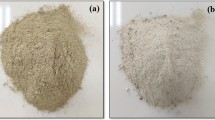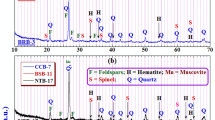Abstract
In this paper, azodicarbonamide (AC), a thermo-sensitive chemical blowing agent, was applied to produce the lightweight fired clay brick with low thermal conductivity and suitable mechanical property. Rice husk was also added to induce the ancient brick texture and brick reinforcement for the archeological site maintenance purpose. Prior to production, thermal decomposition of AC was estimated to design the firing condition, and it was added from 0 to 3.0 pph. AC exhibited suitable thermal sensitivity that could begin pore formation via gas releasing process at the firing temperature of 300 °C. X-ray fluorescence (XRF) indicated that the chemical compositions of the clay bricks before and after firing were the same excepted for Cl, which was possibly liberated under firing process. X-ray diffraction (XRD) analysis showed some structural changes and the crystal transformation after firing. In comparison, all chemical-blown bricks showed the significant decrease of bulk density, indicating the capability of AC to lighten the brick by generating the porous structure. The compressive strength values were higher than the requirement value of the severe weathering grade of the clay brick, which was specified by ASTM C62-12. In summary, the optimal use of AC blowing agent of 2.0 pph with the assistance of rice husk provided the bricks with lower bulk density, higher specific compressive strength, higher porosity and lower thermal insulation properties than neat fired clay brick.










Similar content being viewed by others
Data availability
The data that support the findings of this study are available from the corresponding author on request.
References
Mahasuwanchai P, Athisakul C, Sairuamyat P, Tangchirapat W, Leelataviwat S, Chucheepsakul S (2021) An alternative method for long-term monitoring of Thai historic pagodas based on terrestrial laser scanning data: a case study of Wat Krachee in Ayutthaya. Adv Civ Eng 2021:5587046. https://doi.org/10.1155/2021/5587046
Ma S, Wang L, Bao P (2022) Study on properties of blue-brick masonry materials for historical buildings. J Renew Mater 10(7):1961–1978. https://doi.org/10.32604/jrm.2022.018755
Wethyavivorn B, Surit S, Apichatyakul C, Lerdsivanon N (2016) Model verification of Thai historic masonry monuments. J Perform Constr Facil 30:04014188. https://doi.org/10.1061/(ASCE)CF.1943-5509.0000697
Solikin M, Ikhsan N (2018) Styrofoam as partial substitution of fine aggregate in lightweight concrete bricks. In: AIP conference proceedings, vol 1977, p 030041. https://doi.org/10.1063/1.5042961
Maza-Ignacio OT, Jiménez-Quero VG, Guerrero-Paz J, Montes-García P (2020) Recycling untreated sugarcane bagasse ash and industrial wastes for the preparation of resistant, lightweight and ecological fired bricks. Constr Build Mater 234:117314. https://doi.org/10.1016/j.conbuildmat.2019.117314
Pérez-Villarejo L, Eliche-Quesada D, Martín-Pascual J, Martín-Morales M, Zamorano M (2020) Comparative study of the use of different biomass from olive grove in the manufacture of sustainable ceramic lightweight bricks. Constr Build Mater 231:117103. https://doi.org/10.1016/j.conbuildmat.2019.117103
Abdul Kadir A, Sarani NA (2020) Utilization of palm oil fuel ash in brick manufacturing for lightweight fired clay brick production. Int J Sustain Constr Eng Technol 11:136–150. https://doi.org/10.30880/ijscet.2020.11.01.014
Sutas J, Mana A, Pitak L (2012) Effect of rice husk and rice husk ash to properties of bricks. Procedia Eng 32:1061–1067. https://doi.org/10.1016/j.proeng.2012.02.055
Petchwattana N, Covavisaruch S (2011) Influences of particle sizes and contents of chemical blowing agents on foaming wood plastic composites prepared from poly(vinyl chloride) and rice hull. Mater Des 32(5):2844–2850. https://doi.org/10.1016/j.matdes.2010.12.044
Wang Y, Hu Z, Liu J (2023) Freeze-thaw resistance of concrete containing azodicarbonamide expansive agent. Constr Build Mater 367:130335. https://doi.org/10.1016/j.conbuildmat.2023.130335
Robledo-Ortiz JR, Zepeda C, Gomez C, Rodrigue D, González-Núñez R (2008) Non-isothermal decomposition kinetics of azodicarbonamide in high density polyethylene using a capillary rheometer. Polym Test 27(6):730–735. https://doi.org/10.1016/j.polymertesting.2008.05.004
Charoeythornkhajhornchai P, Samthong C, Boonkerd K, Somwangthanaroj A (2017) Effect of azodicarbonamide on microstructure, cure kinetics and physical properties of natural rubber foam. J Cell Plast 53(3):287–303. https://doi.org/10.1177/0021955x16652101
Lu T, Li J, Han X, Liu R, Cai C, Wang H (2022) Effect of blowing agent concentration of ultra-low density NBR/PVC composite foams on compressive behavior and energy‐absorption characteristics. J Vinyl Addit Technol 28:640. https://doi.org/10.1002/vnl.21915
Dou Y, Rodrigue D (2022) Morphological, thermal and mechanical properties of recycled HDPE foams via rotational molding. J Cell Plast 58(2):305–323. https://doi.org/10.1177/0021955x211013793
Aravind SL, Sivapirakasam SP, Balasubramanian KR, Surianarayanan M (2020) Thermo-kinetic studies on azodicarbonamide/potassium periodate airbag gas generants. Process Saf Environ Prot 144:15–22. https://doi.org/10.1016/j.psep.2020.06.050
Chiang K-Y, Chou P-H, Hua C-R, Chien K-L, Cheeseman C (2009) Lightweight bricks manufactured from water treatment sludge and rice husks. J Hazard Mater 171:76–82. https://doi.org/10.1016/j.jhazmat.2009.05.144
Al-Hadhrami LM, Ahmad A (2009) Assessment of thermal performance of different types of masonry bricks used in Saudi Arabia. Appl Therm Eng 29(5):1123–1130. https://doi.org/10.1016/j.applthermaleng.2008.06.003
Charai M, Sghiouri H, Mezrhab A, Karkri M, El Hammouti K (2020) Comparative study of a clay before and after fired brick-making process. Mater Today Proc 31:S103–S108. https://doi.org/10.1016/j.matpr.2020.06.250
Lopez-Gonzalez E, Salmazo LO, Lopez-Gil A, Rodriguez-Perez MA (2019) Study of the effect of different electron irradiation doses on the decomposition temperature of azodicarbonamide. Polym Eng Sci 59(4):791–798. https://doi.org/10.1002/pen.25007
Bories C, Borredon M-E, Vedrenne E, Vilarem G (2014) Development of eco-friendly porous fired clay bricks using pore-forming agents: a review. J Environ Manag 143:186–196. https://doi.org/10.1016/j.jenvman.2014.05.006
Hossain SS, Mathur L, Majhi MR, Roy PK (2019) Manufacturing of green building brick: recycling of waste for construction purpose. J Mater Cycles Waste Manag 21(2):281–292. https://doi.org/10.1007/s10163-018-0788-4
De Silva GHMJS, Perera BVA (2018) Effect of waste rice husk ash (RHA) on structural, thermal and acoustic properties of fired clay bricks. J Build Eng 18:252–259. https://doi.org/10.1016/j.jobe.2018.03.019
De Silva GHMJS, Surangi MLC (2017) Effect of waste rice husk ash on structural, thermal and run-off properties of clay roof tiles. Constr Build Mater 154:251–257. https://doi.org/10.1016/j.conbuildmat.2017.07.169
Wang P, Wang Y, Yang S, Niu W, Wang X, Li P (2022) Analysis, simulation and experimental study of the tensile stress calibration of ceramic cylindrical pressure housings. J Mar Sci Eng 10(4):499. https://doi.org/10.3390/jmse10040499
Salih MM, Osofero AI, Imbabi MS (2020) Constitutive models for fibre reinforced soil bricks. Constr Build Mater 240:117806. https://doi.org/10.1016/j.conbuildmat.2019.117806
Sena da Fonseca B, Galhano C, Seixas D (2015) Technical feasibility of reusing coal combustion by-products from a thermoelectric power plant in the manufacture of fired clay bricks. Appl Clay Sci 104:189–195. https://doi.org/10.1016/j.clay.2014.11.030
Han W, Pei S, Liu F (2022) Material characterization of the brick in the Ming Dynasty heritage wall of Pianguan County: a case study. Case Stud Constr Mater 16:e00940. https://doi.org/10.1016/j.cscm.2022.e00940
Ottosen LM, Bertelsen IMG, Jensen PE, Kirkelund GM (2020) Sewage sludge ash as resource for phosphorous and material for clay brick manufacturing. Constr Build Mater 249:118684. https://doi.org/10.1016/j.conbuildmat.2020.118684
Aydin T (2018) Development of porous lightweight clay bricks using a replication method. J Aust Ceram Soc 54:169–175. https://doi.org/10.1007/s41779-017-0138-3
La Rubia-García MD, Yebra-Rodríguez Á, Eliche-Quesada D, Corpas-Iglesias FA, López-Galindo A (2012) Assessment of olive mill solid residue (pomace) as an additive in lightweight brick production. Constr Build Mater 36:495–500. https://doi.org/10.1016/j.conbuildmat.2012.06.009
Phonphuak N, Chindaprasirt P (2018) Utilization of sugarcane bagasse ash to improve properties of fired clay brick. Chiang Mai J Sci 45(4):1855–1862
Eliche-Quesada D, Felipe-Sesé MA, López-Pérez JA, Infantes-Molina A (2017) Characterization and evaluation of rice husk ash and wood ash in sustainable clay matrix bricks. Ceram Int 43:463–475. https://doi.org/10.1016/j.ceramint.2016.09.181
Peng Y, Peng X, Yang M, Shi H, Wang W, Tang X, Wu Y (2020) The performances of the baking-free bricks of non-sintered wrap-shell lightweight aggregates from dredged sediments. Constr Build Mater 238:117587. https://doi.org/10.1016/j.conbuildmat.2019.117587
Bompa DV, Elghazouli AY (2020) Compressive behaviour of fired-clay brick and lime mortar masonry components in dry and wet conditions. Mater Struct 53(3):60. https://doi.org/10.1617/s11527-020-01493-w
Merello P, Fernández-Navajas Á, Curiel-Esparza J, Zarzo M, García-Diego F-J (2014) Characterisation of thermo-hygrometric conditions of an archaeological site affected by unlike boundary weather conditions. Build Environ 76:125–133. https://doi.org/10.1016/j.buildenv.2014.03.009
Berardi U (2019) The impact of aging and environmental conditions on the effective thermal conductivity of several foam materials. Energy 182:777–794. https://doi.org/10.1016/j.energy.2019.06.022
Arslan C, Gencel O, Borazan I, Sutcu M, Erdogmus E (2021) Effect of waste-based micro cellulose fiber as pore maker on characteristics of fired clay bricks. Constr Build Mater 300:124298. https://doi.org/10.1016/j.conbuildmat.2021.124298
Acknowledgements
The authors would like to thank the Upper Central Research Network (UCRN) for the financial support of this research. We acknowledge the supports of Dr. Pornnapa Kasemsiri, Dr. Phisut Naknaen, Dr.Thanut Amatayakul and Dr.Wasinee Channuan.
Funding
This research was financial supported by the Upper Central Research Network (UCRN) research grant (Contract no. 012/2554).
Author information
Authors and Affiliations
Corresponding author
Ethics declarations
Conflict of interest
The authors declare no conflict of interest.
Additional information
Publisher's Note
Springer Nature remains neutral with regard to jurisdictional claims in published maps and institutional affiliations.
Rights and permissions
Springer Nature or its licensor (e.g. a society or other partner) holds exclusive rights to this article under a publishing agreement with the author(s) or other rightsholder(s); author self-archiving of the accepted manuscript version of this article is solely governed by the terms of such publishing agreement and applicable law.
About this article
Cite this article
Sukkaneewat, B., Petchwattana, N. & Sanetuntikul, J. Lightweight fired clay brick production for archeological heritage site maintenance application. Mater Struct 56, 111 (2023). https://doi.org/10.1617/s11527-023-02197-7
Received:
Accepted:
Published:
DOI: https://doi.org/10.1617/s11527-023-02197-7




